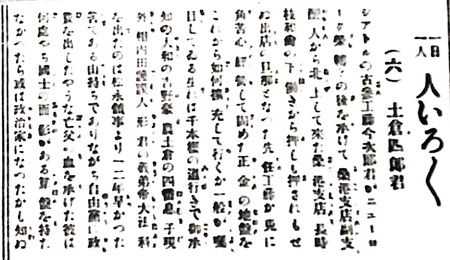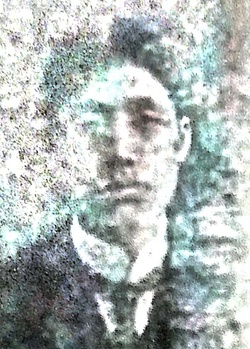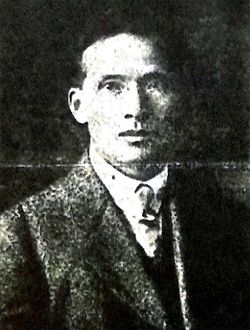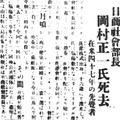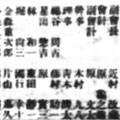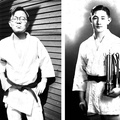In the last chapter, I introduced some articles about the growth of Japanese businesses in Seattle in and after 1917. This time I would like to present The North American Times articles about some notable people in Seattle.
“One Person a Day – Let Us Introduce Them” (1919)
In 1919, The North American Times published a column titled “Ichinichi hitori hito iroiro” (One Person a Day – Let Us Introduce Them) that featured notable people working in various fields in Seattle, one per day, from January to February. The articles introduced their accomplishments and unknown facts about them with a touch of humor. I would like to introduce some of them.
Part 5: Kametaro Hirade (Hirade Store) (Jan. 8, 1919 issue)
He was raised by the Hirade family, grew up in Yokohama, came to America in short pants and studied at a vocational school in New York. With his retail business gradually expanding, his success today is surely a result of his hard work. He looks like a “bochan” (childish man) on the outside but people say he’s a tough one to deal with, who knows exactly what he’s doing.
Based on this article, we can assume that Kametaro Hirade was good at what he did and had great management skills. He took over Hirade Shoten, a retail store which sold groceries and miscellaneous Japanese goods and was started by his father-in-law, Kuranosuke (who moved to the U.S. in 1892). According to Sumisato Arima’s “Shiatoru nikkan hojishi no 100-nen” (100 Years of Daily Japanese Newspapers in Seattle), Kametaro was the marriage matchmaker for Sumiyoshi and Tamaki Arima in Seattle in 1924. Hirade also served as chairperson of the North American Japanese Association (Nihonjin-kai) from 1926.
Part 7*1: Shiro Dogura (manager at a new branch of Yokohama Specie Bank, Seattle) (Jan. 10, 1919 issue)
(Dogura) moved up north from the position of assistant manager at a branch in San Francisco after Imajiro Kudo, an old-timer in Seattle, left for New York, getting a promotional transfer. . . . The public is now watching how he’s going to expand Specie’s business, standing on its foundation that his predecessor Kudo worked so hard to establish. (Dogura) was born the fourth son of a pawnbroker who became a wealthy farmer of Yoshino cherry trees in Yamato, widely known as the setting of the kabuki drama, ‘One Thousand Cherry Trees’ . . . Inheriting a rather unique characteristic of his deceased father who, despite having the title of a mountain owner, offered financial support for the Liberal Party, he appears to have the look of a provincial governor. He might have become a politician had he not chosen an abacus.
As I mentioned in the last chapter, Yokohama Specie Bank from Japan opened its Seattle branch in 1917. Imajiro Kudo was the first branch manager and Dogura succeeded his position.
In the December 2, 1918 issue, there is an article reporting on the farewell/welcome party held for Kudo and Dogura respectively, hosted by Masajiro Furuya (founder of Furuya Store and Nihon Shogyo Bank) at “Maneki” restaurant. It seems that the party was attended by many guests, including Consul Naokichi Matsunaga. Miyazaki* from the North American Times was also there. (*I assume this “Miyazaki” is Tokunosuke Miyazaki, whose name is on the staff list in the Jan. 1, 1919 issue of The North American Times.)
As for Imajiro Kudo, he had his own article published in the January 1, 1918 issue as the branch manager of Yokohama Specie Bank.
I started as a supervisor when Yokohama Specie Bank opened its office in Seattle and foreign exchange trading went exceptionally well which led our business to achieve solid results. . . .The majority of our clients were found in Seattle, as we had not heard of most of them. We did have big and famous companies, too, such as Mitsui Bussan (Mitsui Products) and Suzuki Shoten, but the fact that the majority of deals were made by emerging traders made me reflect deeply . . . Having transferred to the site, I was amazed by the significant progress made by the Japanese community every time I heard or saw its great development, business growth, established foundation, and orderly social structure.
Imajiro Kudo, a pioneer of a Seattle foreign exchange bank, contributed to the growth of the trading business. He was fluent in English and taught it to many Japanese residents in Seattle. In his youth, he had entered the University of Washington and studied languages diligently (Takeuchi, 1929)
Part 8: Yasutaro Kawakami (company president of American Table Sauce) (Jan. 11, 1919 issue)
Table Sauce sells delicious butter that’s about one-inch in size, specifically made for lunch. Actively working, he has shown his business talent since he came to Seattle and has the guts to devote himself to making things come true. Being a jack-of-all-trades, master of none, his business has yet to thrive, but I believe he’s the kind that will make it eventually.
With a photo, Kawakami is featured in the January 1, 1918 issue as well.
After graduating from Yokohama Shogyo High School, Kawakami moved to the U.S. in 1893 and embarked on a trip to explore Alaska right away. He didn’t bow down to whites coming his way and opened a Western-style restaurant/grocery store on the same site in Juneau, making it a financial success. While in America, he struggled in every way possible to develop the sauce which he specifically targeted at white people’s tastes. With a belief that it would benefit his home country, he has given up his original business and now is focused on manufacturing and selling the new product which is gradually gaining a market share.
While most Japanese took on profitable businesses on their arrival in America, Yasutaro Kawakami let go of his prior business to develop a new product. His courage to be up for such a challenge is astonishing.
Part 24: Toyotaro Namura (manager at the Sumitomo Bank branch in Seattle) (Feb. 4, 1919 issue)
(Namura) is a graduate of Kobe Commercial High School whose personality can be described as quite good-natured and approachable. His dedicated attitude, which is supposedly Sumitomo’s style, is a bit different from how Yokohama Specie does its work. His constantly introverted, solid way of working would probably suit a cash-box security guard.
As I reported in the last chapter, Sumitomo Bank opened its first branch in Seattle in 1918. It supported the Japanese community by helping Japanese residents make deposits and send money back home.
Part 25: Ole Hanson (Mayor of Seattle) (Feb. 10, 1919 issue)
Starting as a bootblack (shoeshine boy), (Hanson) worked his way up to become the person he is today. He liked politics but knew that money was essential, so he took on the business of buying and selling houses and land and made quite a fortune from newspaper advertisements. A Scandinavian who has the trust of his compatriots, he was elected a state representative from King County after serving as city councilor. He took on his current position, winning over former Mayor (Hiram) Gill.
I found two articles about Ole Hanson in the North American Times. One was published in the February 20, 1918 issue with the headline “Mr. Hanson Wins Majority Vote in Seattle Mayor Election.” Reporting the election result, “Mr. Hanson won 40% of the votes cast in the election, winning over the current mayor and becoming the newly elected mayor.” The other was published as a commentary with the title “Mayor of Labor” on the first page of the August 16, 1918 issue.
As Mayor of Seattle, a city with a population of 450,000, Ole Hanson works as a regular employee at Erickson Shipbuilding. After finishing his public service for the day at 4 p.m., he puts on his uniform and cotton hat to work and sweat for eight hours until midnight. From a Japanese perspective, it seems as though a person whose social position grants such authority as that of a mayor is losing his dignity by working as a shipyard mechanic... An American with a sense of individualism and dedication to service surely shows something that the Japanese should learn, too.
The Scandinavian mayor was an extremely hard-working person who worked his way up like many Japanese immigrants. Despite the anti-Japanese movement of the day, this article shows the mood of friendship between Japan and the U.S., encouraging readers to learn about a mayor who sets aside his pride and dedicates himself to work.
Part 26: Toyojiro Tsukuno (Head of Japanese Western-style Diners Union) (Feb. 11, 1919 issue)
Finding himself caught up in a ‘sympathetic strike,’ (Tsukuno) is the head of the Japanese Western-style Diner Union from Yamanashi Prefecture and the younger brother of the deceased Matajiro and older brother of Ichizo at Nichibei-Kogyo-sha. He is a real Seattle old-timer who stepped on Japan’s soil for the first time in 25 years when his sister-in-law passed away last year. Arriving in the states in short pants, he learned English from Imajiro Kudo (above) who has recently moved to New York, making him quite an antique. Having operated a restaurant for many years, he stands out among the crowd of his peers from his prefecture. He is such an affable guy. He is not the kind who we could picture as a ‘Yamanashi Monkey.’
There is an excerpt from chapter 1 of this series that featured Tsukuno around 1919. He spoke in detail about Main Street in the late 19th century like a walking encyclopedia. The “sympathetic strike” refers to the factory strike by whites in Seattle which occurred in the beginning of February 1919. In support of the white community, the Japan Western-style Diners Union decided to close down immediately (reported in the Feb. 5 issue of the same year).
(Tsukuno’s) older brother Matajiro Tsukuno was a notable person himself, who ran Toyo Trading Co. as company president. The younger brother Toyojiro moved to the U.S. in 1896 and opened several restaurants. He also served as the first chairperson of Yamanashi Kenjinkai (prefectural association).
There are many other notable people featured in the paper, whom I plan to cover in later chapters of this column.
In the next chapter, I will write about some Japanese Consuls who were appointed in the Japanese Consulate in Seattle.
Note:
1. In the issue of January 10, 1919, the Dogura story was presented as the 6th installment, but it was the 7th installment of “One Person a Day – Let Us Introduce Them” column. So here it is mentioned as part 7.
Reference:
Jushiro Kato, Hokubei Doho Hatten-shi (History of the Growth of Fellow Japanese), Hakubun-sha, 1908.
Kojiro Takeuchi, Beikoku Seihokubu Nihon Imin-shi (History of Japanese Immigrants in the Northwestern United States), Taihoku Nippo-sha, 1929
*The English version of this series is a collaboration between Discover Nikkei and The North American Post, Seattle’s bilingual community newspaper. This article was originally publishd on April 9, 2022 in The North American Post.
© 2022 Ikuo Shinmasu


